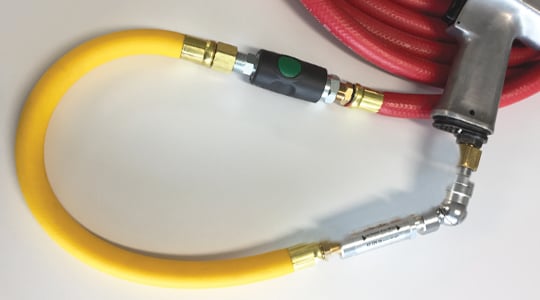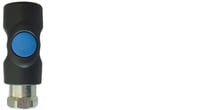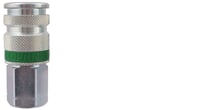There are different models of quick coupler fittings, all with dimensions, materials and features that make them unique. It's necessary to prioritize a coupler over another according to the application for which it will be used. Always keep in mind the desired level of safety, efficiency and performance you seek. In order to guide you through your selection process, we have listed here the most important criteria to consider.
When choosing a coupler consider accident prevention
Safety is always the first element to consider. There are several sources of accidents related to the use of compressed air. Unfortunately, these accidents can have serious consequences for users and pneumatic equipment. Preferably, opt for a quick-release coupling that prevents dangerous hose whips or accidental disconnections.
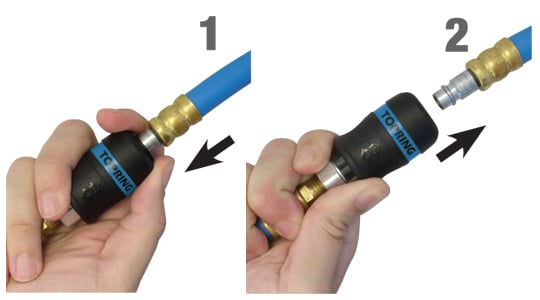
Discover our safety solutions with our two-step disconnection couplings.
|
|
Zero pressure disconnection quick coupler |
|---|---|
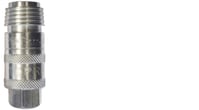 |
Zero pressure connection/disconnection quick coupler L’about est connecté et sécurisé avant que l’alimentation en air ne puisse être ouverte, assurant une connexion sécuritaire et facile. Lors de la déconnexion, la pression d’air en aval est relâchée avant que l’about ne puisse être déconnecté, éliminant ainsi la possibilité du coup de fouet. |
 |
An integrated drag guard prevents accidental disconnections. A drag guard protects the fitting sleeve from releasing the plug while under pressure. |
When choosing a coupler consider the air pressure and flow requirements of the applications (PSI and SCFM)
Air tools operate at variable air pressures and airflow rates specified by the manufacturers. The inside diameter of the air hose used can match the size of the fitting (e.g. ¼ I.D. hose, ¼ fitting). However, air pressure and air volume restrictions such as a 1/2 I.D. hose with a ¼ fitting must be avoided. The maximum operating pressure of the selected connection must be equal to or greater than the maximum pressure of the compressed air system.
| ⚠️CAUTION ⚠️ |
| Over-pressurization could result in a sudden failure of the coupler causing serious or fatal injury. Select the fitting that best fits your application and follow the manufacturer’s suggested specifications. |
When choosing a coupler consider the plug profile used
The plug profile determines the coupler to be used. Most quick coupler fittings are associated with a single plug profile (except for the “Universal” type coupler that accepts multiple plug profiles). The opening of the plug determines the quantity of air (SCFM). Use a template to easily identify plug profiles and threads.
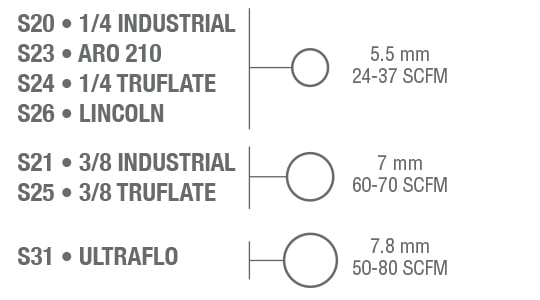 For example, the ULTRAFLO S31 plug has an opening of 7.8 mm and delivers flow rates from 50 to 80 SCFM.
For example, the ULTRAFLO S31 plug has an opening of 7.8 mm and delivers flow rates from 50 to 80 SCFM.
When choosing a coupler consider the frequency of connection/disconnection
The connection/disconnection frequency of the coupler plays an important part in the choice of fitting. If you must disconnect the fitting several times a day, you will opt for an automatic coupler (more practical than a manual quick-release coupling).
Automatic quick coupler
Insert the plug into the fitting without having to activate the sliding sleeve manually (must be activated for disconnection).
Manual quick coupler
Manually retract the sleeve to connect or disconnect the plug.
When choosing a coupler consider the working conditions
Consider the working environment when choosing a quick-release coupling. Environmental and working conditions sometimes require the use of stronger or non-corroding fittings. Depending on the type of industry, consider the standards related to the use of compressed air.
|
|
Greater resistance to harsh environments with corrosive elements due to their steel construction. Greater resistance to applications with frequent impacts and high operating pressures. |
|---|---|
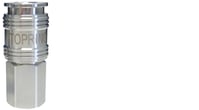 |
Perfect for environments where ambient conditions including humidity, water, chemicals, and air contaminants can cause premature wear of the fittings. |
When choosing a coupler consider the protection of delicate surfaces
In specific industries and applications, the risk of scratches on finished products is unacceptable (car body, furniture manufacturing, etc.). Use scratch-resistant fittings, such as polyamide fittings, when the situation requires it. Polyamide fittings are also very light compared to metal fittings. They, therefore, offer better ergonomics if you handle them often. To avoid eventual discomfort, opt for a lightweight and practical solution.
Polyamide quick coupler
Effective protection of delicate surfaces against scratches. Very light compared to metal fittings and better ergonomics for the user.
Useful tips:
Improve the ergonomics of the tool with a free-angle fitting
For superior ergonomics, combine your quick-release coupling with a free-angle plug (also called “free-angle fitting”). Free angle fittings offer improved tool handling and help reduce fatigue at the wrist.
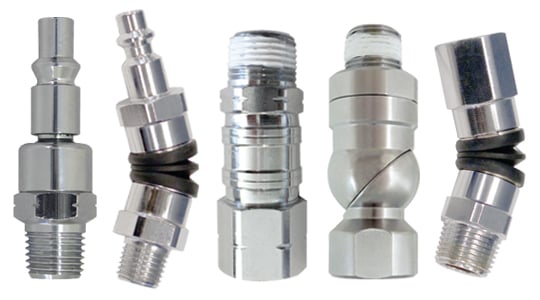
Increase the service life of the coupler with an anti-whip hose
Take all necessary precautions to increase the life of the quick-release coupling. A short anti-whip hose between the tool and the fitting will isolate the vibration connection and prolong its life while reducing the danger of whiplash. Shock absorbers are highly recommended for all impact and vibration tools. Moreover, the use of an anti-whip hose improves ergonomics by offering better handling of the tools.
